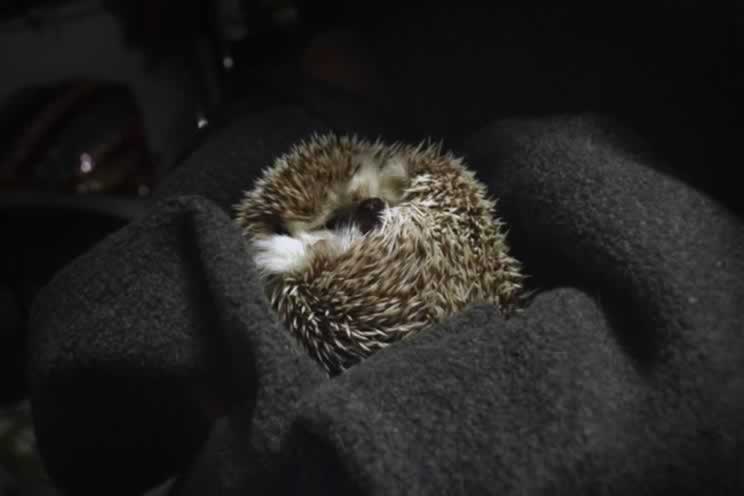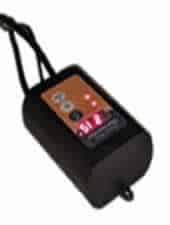
During my daughter’s research about hedgehogs, hibernation was an important area. She wanted to know if in the wild they automatically hibernated and the steps they took to be ready to hibernate.
Do hedgehogs hibernate when they are pets? Hedgehogs can go into hibernation if they become too cold especially if the temperature of their surroundings falls below the minimum recommended temperature of 72F (22C ). Hibernation symptoms will start with them being lethargic, unable to curl and unsteady when standing.
Where we live, it can get pretty cold in the winter with temperatures sometimes falling to below zero, so we take plenty of measures to ensure our hedgehog doesn’t succumb to the cold. I’ll discuss a few of the measures we use in the following parts of this article.
1. Keep a controlled room temperature
We tend to keep our heating set to come on if the temperature drops to 60F (16C). It’s important to not put a hedgehog into a freezing cold room, as their cage can quickly lose heat. Irrespective of whether there is some form of heating equipment in the cage.
The thing that always worries me, is the heating used in cage failing and with an exceptionally cold room, this could become a nightmare scenario for a hedgehog. Anything powered by electricity could stop working from failure (even the most reliable brands can break), power cuts or surges in supply.
Should the heating in the cage fail, the backup plan becomes non-existent if there’s not an adequate supply of heat in the background, that is the room where the cage is kept.
If you don’t have your heating on all the time in colder months, try to put it on at a time to even out the temperature. We put the heating between 6 am and 9 am in the morning and then between 4 pm and 7 pm.
2. Use a Heat Mat
We have a heat mat in the cage (where hedgehogs house is) set to come on if the temperature drops to 72F (22C). The heat mat has a thermostat (automatic temperature control) where we set the minimum temperature to come on.
3. Use a Heat Lamp
A Heat Lamp (Ceramic Heat Emitter) is a good option for non-plastic cages or any cages that could pose a fire risk with one of these types of Heat Lamps.
Just like a Heat Mat, a thermostat and a thermometer are required to be able to control the temperature in a cage like a Vivarium.
We didn’t try one of these lights which emit heat which is generally used in cages used for reptiles. We just didn’t feel confident enough with these types of heat lamps being able to provide enough heat.
More importantly, our hedgehog’s house and cage are made of plastic, so there would have been a fire risk. Also, the hedgehog house would have been cold as the heat would not have been able to penetrate inside.
We did also contemplate having both a heat mat inside the house and a heat lamp near where his food and water is but then there would be no heat near to his running wheel, so it would kind of defeat the object of trying to keep all the cage warm.
We decided against this as we had a fallback temperature on our heating in our home which would come on if the temperature dropped to 16C (60F), as well as a good cycle of heating to keep the overall temperature of our home relatively comfortable.
4. Use a sleeping pouch
Fortunately, our hedgehog is smart enough to sleep in a pouch on the heat mat in the colder months. His house is on the heat mat with the pouch inside, so not only is it warm enough for him, but it’s also his place to hide and sleep.
In the warmer months, the heat from his heat mat doesn’t come on, so he can still sleep in his house but we noticed early on, he’d sleep on top of the pouch instead of in it during these warmer months. Which is understandable considering how warm it gets in the spring and especially summer.
5. Use Low Watt Heaters
We did also consider very low watt heaters to put next to the cage as these can cost very little to run but the worry here was that the heat would be lost quickly to the surrounding area with not enough heat actually getting into the cage.
The risk of fire is also a worry with any heating so we have a smoke alarm directly above the cage on the ceiling. The heat mat isn’t too much of a worry as the temperature is low and I have plugged into a surge-protected electrical socket.
6. Watch out for drafts
Don’t put hedgehogs near to drafts. At the end of the room where we keep our hedgehog we have glass doors which can get cold, so we keep his cage on the opposite side of the room. We have also put in draft excluders on all the doors in the same room as the cage.
7. Night and Day distinction
Don’t be tempted to put a hedgehog in a small room where there’s no distinction between daylight and night. This will totally screw up the hedgehogs’ body clock.
What are the symptoms of hibernation for a hedgehog?
By knowing how your hedgehog behaves normally, it can become easier to spot changes that could be signs of falling or starting to fall into a state of hibernation. If the hedgehog looks like it doesn’t have the same energy and zip as normal then this would need investigating further.
If they have any of the following symptoms then these could be tell-tale signs of possibly the beginnings of hibernation:
- look overly tired;
- aren’t moving as much as they normally do;
- have difficulty uncurling from their ball position;
- struggle to curl up into a ball position;
- if they look weak;
- have trouble try to stand; or
- trouble trying to stay standing.
Other signs may include eating less than normal and looking like they’ve lost weight. Again it’s important to be extra vigilant in the colder months by trying to check for any changes which could be signs of pending hibernation. We’re used to our hedgehogs routine and if there was a change to this, we’d notice and would want to investigate.
How do you revive a hedgehog that’s gone into hibernation?
It’s important to revive any hedgehogs that have gone into hibernation using a safe amount of heat. Generally, your body heat is sufficient and putting the hedgehog next to your abdomen with a towel on top of the hedgehog, could provide heat slowly to revive them.
Special care and consideration should be taken if you plan on using one of those heat mats which you warm up in the microwave. These can quickly get too hot and if the hedgehog is left unsupervised could end up being burned.
Instead by using a heating pad with a thermostat that regulates temperature could be a better option but you would still need to be extra vigilant with a hedgehog being revived from hibernation and keep an eye on them and not leave them for prolonged periods of time alone.
Once a hedgehog has been revived from premature hibernation, they need to be taken to a vet and get checked out. This could help in determining why they went into hibernation in the first place, there could be an underlying medical reason or it really was simply down to it being too cold. Steps can then be taken to ensure hibernation is not repeated.
Aestivation (Estivation)
Just as the cold can be bad for hedgehogs, extreme heat can also play havoc, especially as the hedgehog could enter into an Aestivation (estivation) state. This is where their metabolism rate slows down to try to cope with the extra heat. This slowing down may not be as much as with hibernation but enough to possibly make it difficult for them to return their metabolic rate to normal.
Whilst I don’t think this could occur is if the heating in your house is constantly kept on at a high temperature, I do think it could occur on a really hot day in our conservatory (sunroom) as the temperature can rapidly escalate.
This is why we rarely leave him in that room unsupervised, generally taking him in for a few minutes to explore before taking him back to a room with a more appreciable temperature. I did speak to my vet about Aestivation and they said it was rare for hedgehogs to go into this state.
Regulated Temperature is best
In conclusion, it’s absolutely vital to ensure the temperature is regulated in both the colder and the warmer months, so hibernation and the rarer aestivation can be prevented.
Can a hedgehog die from hibernation?
A hedgehog can die if it falls into hibernation especially if they are not revived within the first 72 hours of hibernation. The first 72 hours is a critical period between life and death for the hedgehog, with any delay in trying to revive a hedgehog becoming critical.
The risk of hibernation seems to increase with age and this is probably down to them feeling the cold more. One of my daughter’s friends who also has a pet hedgehog, mentioned that because he’s quite old now (she couldn’t remember exactly how old) that he’s on a few occasions gone into hibernation and she’s had to take steps to revive him.
Why do hedgehogs die if they hibernate?
In the wild hedgehogs would tend to eat more in the warmer months and build up a reserve of fat. This fat would then be used for energy if they went into hibernation later in the colder months. The metabolic rate of the hedgehogs would slow drastically during hibernation, allowing the hedgehog to slowly digest their fat reserves to survive the colder months.
A pet hedgehog wouldn’t have built up sufficient fat reserves to survive hibernation, as their food could be restricted to stop them becoming obese or the temperature is controlled throughout the year, so the hedgehog doesn’t overfeed and therefore doesn’t build up fat reserves.
The problem arises when the expected temperature drops suddenly and the hedgehog goes into hibernation. There simply is not enough energy in reserve to keep the hibernation going for a prolonged period. This is why the first 72 hours seem to be vital in reviving the hedgehog, as after this the hedgehog will simply starve to death.
The cold itself could also kill the hedgehog through hypothermia, especially if the cold is severe, just like it could do to vulnerable people, like the old and infirm.
What you can do to prevent an hedgehog from going into hibernation?
Keeping the hedgehogs warm is essential especially during the colder months. Whilst it may be difficult to maintain an effective warm temperature across the whole of the cage, it’s imperative that the house where the hedgehog sleeps in is at least at a safe and survivable temperature for hedgehogs.
Conclusion
It’s important to remember pet hedgehogs are natively from a warm climate and wouldn’t necessarily have to endure the same colder temperatures in the wild. They would also be better prepared in the wild if they did need to go into hibernation unlike in captivity.
Related Questions
Are heating pads safe for hedgehogs? As long as the heating pad has a thermostat (temperature control) and the temperature is not set outside their acceptable range, then heat mats can be safe.
What temperature is good for hedgehogs? Between 72F (22C) and 81F (26.5C) is an acceptable range for hedgehogs. They are smart enough if it’s too cold to seek heat and if it’s too hot, to seek a cooler area of their cage.





